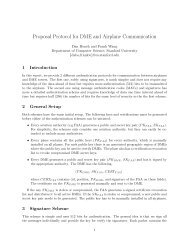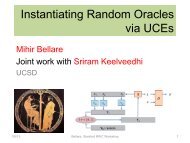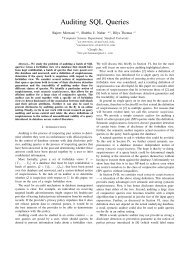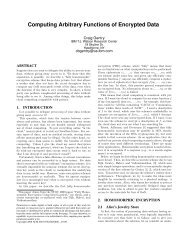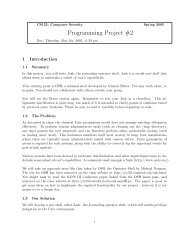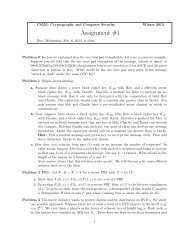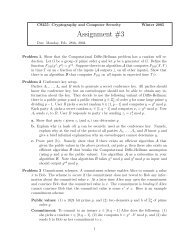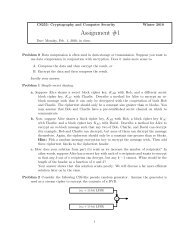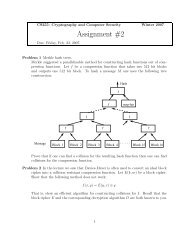Basic web security model - Stanford Crypto Group
Basic web security model - Stanford Crypto Group
Basic web security model - Stanford Crypto Group
You also want an ePaper? Increase the reach of your titles
YUMPU automatically turns print PDFs into web optimized ePapers that Google loves.
<strong>Basic</strong> <strong>web</strong> <strong>security</strong> <strong>model</strong><br />
Elie Bursztein CS155
Vulnerability Stats: <strong>web</strong> is “winning”<br />
Majority of vulnerabilities now found in <strong>web</strong> software<br />
Source: MITRE CVE trends
Web <strong>security</strong>: two sides<br />
Web browser: (client side)<br />
Attacks target browser <strong>security</strong> weaknesses<br />
Result in:<br />
Malware installation (keyloggers, bot-nets)<br />
Document theft from corporate network<br />
Loss of private data<br />
Web application code: (server side)<br />
Runs at <strong>web</strong> site: banks, e-merchants, blogs<br />
Written in PHP, ASP, JSP, Ruby, …<br />
Many potential bugs: XSS, XSRF, SQL injection<br />
Attacks lead to stolen CC#, defaced sites.
Credits<br />
Adam Barth, Collin Jackson,<br />
John Mitchell, Dan Boneh<br />
and the entire <strong>web</strong>sec team<br />
http://crypto.stanford.edu/<strong>web</strong>sec
Outline<br />
Web Refresher:<br />
Security User Interface<br />
Goals of a browser<br />
When is it safe to type my password?<br />
Same-Origin Policy<br />
How sites are isolated<br />
Opting out of isolation<br />
Frame hijacking<br />
Navigation policy<br />
Cookie <strong>security</strong><br />
Browser <strong>security</strong> design
Web Refresher
HTTP protocol<br />
HTTP is<br />
widely used<br />
Simple<br />
Stateless<br />
Unencrypted
Protocol<br />
URLs<br />
Global identifiers of network-retrievable documents<br />
Example:<br />
http://stanford.edu:81/class?name=cs155#homework<br />
Hostname<br />
Port Path<br />
Special characters are encoded as hex:<br />
%0A = newline<br />
Query<br />
%20 or + = space, %2B = + (special exception)<br />
Fragment
HTTP Request<br />
Method File HTTP version Headers<br />
GET /index.html HTTP/1.1<br />
Accept: image/gif, image/x-bitmap, image/jpeg, */*<br />
Accept-Language: en<br />
Connection: Keep-Alive<br />
User-Agent: Mozilla/1.22 (compatible; MSIE 2.0; Windows 95)<br />
Host: www.example.com<br />
Referer: http://www.google.com?q=dingbats<br />
Blank line<br />
Data – none for GET<br />
GET: no side effect. POST: possible side effect.
Cookies<br />
HTTP Response<br />
HTTP version Status code Reason phrase Headers<br />
HTTP/1.0 200 OK<br />
Date: Sun, 21 Apr 1996 02:20:42 GMT<br />
Server: Microsoft-Internet-Information-Server/5.0<br />
Connection: keep-alive<br />
Content-Type: text/html<br />
Last-Modified: Thu, 18 Apr 1996 17:39:05 GMT<br />
Set-Cookie: …<br />
Content-Length: 2543<br />
Some data... blah, blah, blah <br />
Data
Security User Interface<br />
When is it safe to type my password?<br />
11
Safe to type your password?<br />
12
Outline<br />
Web Refresher:<br />
Security User Interface<br />
Goals of a browser<br />
When is it safe to type my password?<br />
Same-Origin Policy<br />
How sites are isolated<br />
Opting out of isolation<br />
Frame hijacking<br />
Navigation policy<br />
Cookie <strong>security</strong><br />
Browser <strong>security</strong> design
Safe to type your password?<br />
14
Safe to type your password?<br />
15
Safe to type your password?<br />
???<br />
???<br />
16
Safe to type your password?<br />
17
Same-Origin Policy<br />
How does the browser isolate different sites?<br />
18
Outline<br />
Web Refresher:<br />
Security User Interface<br />
Goals of a browser<br />
When is it safe to type my password?<br />
Same-Origin Policy<br />
How sites are isolated<br />
Opting out of isolation<br />
Frame hijacking<br />
Navigation policy<br />
Cookie <strong>security</strong><br />
Browser <strong>security</strong> design
Policy Goals<br />
Safe to visit an evil <strong>web</strong> site<br />
Safe to visit two pages at the same time<br />
Address bar<br />
distinguishes them<br />
Allow safe delegation
Components of browser <strong>security</strong><br />
policy<br />
Frame to Frame relationships<br />
canScript(A,B)<br />
Can Frame A execute a script that reads or writes DOM<br />
elements of Frame B?<br />
canNavigate(A,B)<br />
Can Frame A change the origin of content for Frame B?<br />
Frame to cookie relationships<br />
readCookie(A,S), writeCookie(A,S)<br />
Can Frame A read/write cookies from origin S?<br />
SecurityIndicator (W) [ssl lock icon]<br />
Is the <strong>security</strong> indicator displayed for window W?
Popup windows<br />
With hyperlinks<br />
click here<br />
With JavaScript<br />
mywin = window.open(“http://www.b.com”, “foo”,<br />
“width=10,height=10”)<br />
Navigating named window re-uses existing one<br />
Can access properties of remote window:<br />
mywin.document.body<br />
mywin.location = “http://www.c.com”;
Windows Interact<br />
23
Are all interactions good?<br />
24
Frames<br />
Modularity<br />
Brings together content<br />
from multiple sources<br />
Client-side aggregation<br />
Delegation<br />
Frame can draw only on its<br />
own rectangle<br />
src = google.com/…<br />
name = awglogin<br />
src = 7.gmodules.com/...<br />
name = remote_iframe_7
Frames and iFrames<br />
<br />
src=“https://www.google.com/<br />
accounts/ServiceLoginBox”<br />
style=“width:19em; height:16.4em”<br />
Address bar says nothing about origin of embedded content<br />
• frames (ads), scripts, flash objects, CSS<br />
… but says nothing about where embedded content is from<br />
awglogin
Masups: lots of frames (gadgets)<br />
27
Need for isolation - mashups<br />
Malicious gadget should not affect other gadgets
Window Policy Anomaly<br />
top.frames[1].location = "http://www.attacker.com/...";<br />
top.frames[2].location = "http://www.attacker.com/...";<br />
...
A Guninski Attack<br />
window.open("https://attacker.com/", "awglogin");<br />
awglogin<br />
30
What should the policy be?<br />
Child<br />
Sibling<br />
Frame Bust<br />
Descendant<br />
31
Legacy Browser Behavior<br />
Browser Policy<br />
IE 6 (default) Permissive<br />
IE 6 (option) Child<br />
IE7 (no Flash) Descendant<br />
IE7 (with Flash) Permissive<br />
Firefox 2 Window<br />
Safari 3 Permissive<br />
Opera 9 Window<br />
HTML 5 Child
Adoption of Descendant Policy<br />
Browser Policy<br />
IE7 (no Flash) Descendant<br />
IE7 (with Flash) Descendant<br />
Firefox 3 Descendant<br />
Safari 3 Descendant<br />
Opera 9 (many policies)<br />
HTML 5 Descendant
Library import<br />
<br />
• Script has privileges of imported page, NOT source server.<br />
• Can script other pages in this origin, load more scripts<br />
• Other forms of importing
35<br />
Pages can embed content from many<br />
sources (example)<br />
Frames: <br />
Scripts: <br />
CSS:<br />
<br />
Objects (flash): [using swfobject.js script ]<br />
<br />
var so = new SWFObject(‘//site.com/flash.swf', …);<br />
so.addParam(‘allowscriptaccess', ‘always');<br />
so.write('flashdiv');<br />
Cross-origin Interaction<br />
Sites often need to communicate:<br />
Google AdSense:<br />
<br />
Mashups<br />
Gadget aggregators (e.g. iGoogle or live.com)<br />
Primary method: script inclusion; site A does:<br />
<br />
• Script from B runs in A’s origin: full control over A’s DOM<br />
• Note: to communicate with B, site A gives B full control !!
Mashups
Need for isolation: embedded<br />
38<br />
content<br />
3 rd party ad should not read/write enclosing DOM
Recent Developments<br />
Cross-origin network requests<br />
Access-Control-Allow-Origin: <br />
Access-Control-Allow-Origin: *<br />
Cross-origin client side communication<br />
Client-side messaging via navigation (older<br />
browsers)<br />
postMessage (newer browsers)<br />
Site A<br />
Site B<br />
Site A context Site B context
window.postMessage<br />
New API for inter-frame communication<br />
Supported in latest betas of many browsers<br />
A network-like channel between frames<br />
Add a contact<br />
Share contacts
postMessage syntax<br />
frames[0].postMessage("Attack at dawn!",<br />
"http://b.com/");<br />
window.addEventListener("message", function (e) {<br />
if (e.origin == "http://a.com") {<br />
... e.data ... }<br />
}, false);<br />
Attack at dawn!
Why include “targetOrigin”?<br />
What goes wrong?<br />
frames[0].postMessage("Attack at dawn!");<br />
Messages sent to frames, not principals<br />
When would this happen?<br />
42
Data export<br />
Many ways to send information to other origins<br />
<br />
<br />
<br />
<br />
No user involvement required<br />
Cannot read back response<br />
Read response only from your origin<br />
Some port are restricted (SMTP)
Same Origin Requests with<br />
XMLHttpRequest<br />
<br />
var xhr = new XMLHttpRequest();<br />
xhr.open("POST", "http://www.example.com:81/foo/<br />
example.cgi", true); // asynchronous<br />
xhr.send("Hello world!");<br />
xhr.onload = function() {<br />
if (xhr.status == 200) {<br />
alert(xhr.responseText);<br />
}}<br />
<br />
read response<br />
prepare request
Sending a Cross-Domain GET<br />
Data must be URL encoded<br />
<br />
Browser sends:<br />
GET file.cgi?foo=1&bar=x%20y HTTP/1.1<br />
Host: othersite.com<br />
…<br />
⇒ Any <strong>web</strong> page can send info to any site<br />
Denial of Service (DoS) using GET:<br />
a popular site can DoS another site [Puppetnets ’06]
Sending a Cross-Domain POST<br />
<br />
<br />
<br />
document.forms[0].submit()<br />
submit<br />
post<br />
Hidden iframe can do this in background<br />
⇒ user visits a malicious page, browser submits<br />
form on behalf of user<br />
⇒ e.g. page re-programs user’s home router (XSRF)<br />
Can’t send to some restricted ports, like 25 (SMTP)
Cookie Security<br />
How to make HTTP statefull securely ?
Outline<br />
Web Refresher:<br />
Security User Interface<br />
Goals of a browser<br />
When is it safe to type my password?<br />
Same-Origin Policy<br />
How sites are isolated<br />
Opting out of isolation<br />
Frame hijacking<br />
Navigation policy<br />
Cookie <strong>security</strong><br />
Browser <strong>security</strong> design
Same origin policy: “high level”<br />
Review: Same Origin Policy (SOP) for DOM:<br />
Origin A can access origin B’s DOM if match on<br />
(scheme, domain, port)<br />
Today: Same Original Policy (SOP) for cookies:<br />
Generally speaking, based on:<br />
([scheme], domain, path)<br />
optional<br />
scheme://domain:port/path?params
Setting/deleting cookies by server<br />
Browser<br />
if expires=NULL:<br />
this session only<br />
GET …<br />
HTTP Header:<br />
Set-cookie: NAME=VALUE ;<br />
• Delete cookie by setting “expires” to date in past<br />
• Default scope is domain and path of setting URL<br />
Server<br />
domain = (when to send) ;<br />
path = (when to send)<br />
secure = (only send over SSL);<br />
expires = (when expires) ;<br />
HttpOnly (later)<br />
scope
Scope setting rules (write SOP)<br />
domain: any domain-suffix of URL-hostname, except TLD<br />
example: host = “login.site.com”<br />
allowed domains<br />
login.site.com<br />
.site.com<br />
⇒ login.site.com can set cookies for all of .site.com<br />
but not for another site or TLD<br />
Problematic for sites like .stanford.edu<br />
path: can be set to anything<br />
disallowed domains<br />
user.site.com<br />
othersite.com<br />
.com
Cookies are identified by (name,domain,path)<br />
cookie 1<br />
name = userid<br />
value = test<br />
domain = login.site.com<br />
path = /<br />
secure<br />
distinct cookies<br />
Both cookies stored in browser’s cookie jar;<br />
both are in scope of login.site.com<br />
cookie 2<br />
name = userid<br />
value = test123<br />
domain = .site.com<br />
path = /<br />
secure
Reading cookies on server (read SOP)<br />
Browser<br />
GET //URL-domain/URL-path<br />
Cookie: NAME = VALUE<br />
Browser sends all cookies in URL scope:<br />
• cookie-domain is domain-suffix of URL-domain, and<br />
• cookie-path is prefix of URL-path, and<br />
• [protocol=HTTPS if cookie is “secure”]<br />
Goal: server only sees cookies in its scope<br />
Server
Examples<br />
cookie 1<br />
name = userid<br />
value = u1<br />
domain = login.site.com<br />
path = /<br />
secure<br />
http://checkout.site.com/<br />
http://login.site.com/<br />
https://login.site.com/<br />
both set by login.site.com<br />
cookie 2<br />
name = userid<br />
value = u2<br />
domain = .site.com<br />
path = /<br />
non-secure<br />
cookie: userid=u2<br />
cookie: userid=u2<br />
cookie: userid=u1; userid=u2<br />
(arbitrary order)
Client side read/write: document.cookie<br />
Setting a cookie in Javascript:<br />
document.cookie = “name=value; expires=…; ”<br />
Reading a cookie: alert(document.cookie)<br />
prints string containing all cookies available for<br />
document (based on [protocol], domain, path)<br />
Deleting a cookie:<br />
document.cookie = “name=; expires= Thu, 01-Jan-70”<br />
document.cookie often used to customize page in Javascript
Javascript URL<br />
javascript: alert(document.cookie)<br />
Displays all cookies for current document
Viewing/deleting cookies in Browser UI
Cookie protocol problems<br />
Server is blind:<br />
Does not see cookie attributes (e.g. secure)<br />
Does not see which domain set the cookie<br />
Server only sees: Cookie: NAME=VALUE
Interaction with the DOM SOP<br />
Cookie SOP: path separation<br />
x.com/A does not see cookies of x.com/B<br />
Not a <strong>security</strong> measure:<br />
DOM SOP: x.com/A has access to DOM of x.com/B<br />
HttpOnly Cookies IE6 SP1, FF2.0.0.5<br />
Browser<br />
GET …<br />
HTTP Header:<br />
Set-cookie: NAME=VALUE ;<br />
HttpOnly<br />
Server<br />
• Cookie sent over HTTP(s), but not accessible to scripts<br />
• cannot be read via document.cookie<br />
• Also blocks access from XMLHttpRequest headers<br />
• Helps prevent cookie theft via XSS<br />
… but does not stop most other risks of XSS bugs.<br />
(not Safari)
Browser <strong>security</strong> design<br />
How to build a secure browser ?
Outline<br />
Web Refresher:<br />
Security User Interface<br />
Goals of a browser<br />
When is it safe to type my password?<br />
Same-Origin Policy<br />
How sites are isolated<br />
Opting out of isolation<br />
Frame hijacking<br />
Navigation policy<br />
Cookie <strong>security</strong><br />
Browser <strong>security</strong> design
Approach<br />
Fact: Browsers will always have bugs<br />
Goal: Reduce the harm<br />
Frequency of<br />
interactions<br />
with attacker<br />
Percentage of<br />
time vulnerability<br />
is unpatched<br />
Damage if<br />
attack works
Outline<br />
Frequency of<br />
interactions<br />
with attacker<br />
1. Preventing the Introduction<br />
2. Vulnerability Response<br />
3. Failure Containment<br />
Percentage of<br />
time vulnerability<br />
is unpatched<br />
Damage if<br />
attack works
Frequency of<br />
interactions<br />
with attacker<br />
Percentage of<br />
time vulnerability<br />
is unpatched<br />
PREVENTING THE<br />
INTRODUCTION<br />
Damage if<br />
attack works
Drive-by downloads<br />
Silently installs software when<br />
<strong>web</strong> page is loaded<br />
Increase exposure by<br />
compromising other sites and<br />
insert code into them<br />
Sites owners unaware they are<br />
participating in an attack<br />
Provos et al. "All your<br />
iFRAMES Point to Us"
World of Warcraft keylogger<br />
Flash Player exploit used to install keylogger<br />
Links to malicious SWF posted on forums<br />
"Solution": Disable hyperlinks on forum
Scaling it up to the entire <strong>web</strong><br />
1.3% of the incoming<br />
search queries to Google<br />
returned at a least one<br />
malware site<br />
Visit sites with an army of<br />
browsers in VMs, check<br />
for changes to local<br />
system<br />
Indicate potentially<br />
harmful sites in search<br />
results
Now do it in the browser
Helping the <strong>web</strong>master out
Introductions are easy<br />
Impressions are<br />
cheap ($1 = 2000)<br />
Ad that is harmless<br />
today may be<br />
malicious tomorrow<br />
Possible mitigations:<br />
<br />
Frequency of<br />
interactions<br />
with attacker<br />
Percentage of<br />
time<br />
vulnerability is<br />
unpatched<br />
Damage if<br />
attack works<br />
VULNERABILITY RESPONSE
Closing the vulnerability window<br />
Discovery Publication Patch available Patch deployed<br />
Delay publication<br />
Coordinate with <strong>security</strong> researchers<br />
Offer prizes for responsibly disclosed <strong>security</strong> bugs<br />
Make patch available faster<br />
Deploy patch faster
Obstacles to patch deployment<br />
Interrupts work flow<br />
Requires adminstrator privileges<br />
Risk of breaking things<br />
Separate update<br />
mechanisms<br />
Silent approach:<br />
GoogleUpdate.exe
Getting better, but not fast enough<br />
Frei et al. Examination of vulnerable online Web browser populations and the "in<strong>security</strong> iceberg"
Frequency of<br />
interactions<br />
with attacker<br />
Percentage of<br />
time vulnerability<br />
is unpatched<br />
FAILURE CONTAINMENT<br />
Damage if<br />
attack<br />
works
Severity<br />
"Medium"<br />
Universal XSS<br />
"High"<br />
File Theft<br />
Arbitrary Code<br />
Execution<br />
"Critical"
Protected Mode IE<br />
IE7 in Vista is a "low rights" process<br />
Can prompt user to get more privileges
IE7 Containment Goals<br />
Arbitrary code execution won't let attacker:<br />
Install software<br />
Copy files to startup folder<br />
Change homepage or search provider setting<br />
Can we do more?
Containment Goals<br />
Universal XSS File Theft<br />
Arbitrary Code Execution
Chromium Security Architecture<br />
Browser ("kernel")<br />
Full privileges (file<br />
system, networking)<br />
Coarse-grained <strong>security</strong><br />
policies protect local<br />
system<br />
Rendering engine<br />
Sandboxed<br />
Fine-grained same origin<br />
policy enforcement<br />
One process per plugin<br />
Sandboxing optional<br />
Barth et al. "The Security<br />
Architecture of the Chromium<br />
Browser"
Preventing File Theft<br />
File Downloads.<br />
Renderer can only write files to<br />
My Documents\Downloads<br />
File Uploads.<br />
Renderer is granted ability to upload file using<br />
browser kernel's file picker.<br />
Network Requests.<br />
Can only request <strong>web</strong>-safe schemes (http, https,<br />
ftp)<br />
Dedicated renderers for file://
Task Allocation
Is the "kernel" too complex?<br />
Total CVEs:<br />
Arbitrary code execution vulnerabilities:
Another approach: Cookie Blocking<br />
Block the "Cookie" header<br />
for cross-domain resource<br />
loads<br />
Third-party cookie<br />
blocking already does this<br />
for privacy<br />
Third-party frames are ok<br />
Cross-subdomain might<br />
be ok<br />
Open question: How many sites does<br />
this break compared to content type<br />
filtering?
Conclusion<br />
Frequency of<br />
interactions<br />
with attacker<br />
1. Preventing the Introduction<br />
2. Vulnerability Response<br />
3. Failure Containment<br />
Percentage of<br />
time vulnerability<br />
is unpatched<br />
Damage if<br />
attack works



